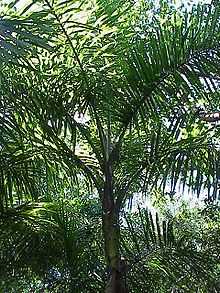Gaussia maya
From Wikipedia, the free encyclopedia
| Gaussia maya | |
|---|---|
 | |
| Conservation status | |
| Scientific classification | |
| Kingdom: | Plantae |
| (unranked): | Angiosperms |
| (unranked): | Monocots |
| (unranked): | Commelinids |
| Order: | Arecales |
| Family: | Arecaceae |
| Genus: | Gaussia |
| Species: | G. maya |
| Binomial name | |
| Gaussia maya (O.F.Cook) H.J.Quero & Read | |
| Synonyms | |
|
Opsiandra maya O.F.Cook | |
Gaussia maya is a palm which is native to Mexico, Belize and Guatemala.[2] The species grows in rocky areas on limestone soils.[3] The species is classified as vulnerable, and is threatened by habitat destruction and degradation.[1]
Gaussia maya are 5 to 20 metres tall. Stems are gray, 10 to 15 (sometimes 30) centimetres in diameter. Trees have six to eight pinnately compound leaves. Fruit are red, 1 to 1.5 cm in diameter.[3] Stems are used for construction.[3]
References
- ↑ 1.0 1.1 "Gaussia maya". IUCN Red List of Threatened Species. Version 2007. International Union for Conservation of Nature. 1998. Retrieved November 16, 2007.
- ↑ "Gaussia gomez-pompae". Royal Botanic Gardens, Kew: World Checklist of Selected Plant Families. Retrieved 2007-11-16.
- ↑ 3.0 3.1 3.2 Henderson, Andrew; Gloria Galeano; Rodrigo Bernal (1995). Field Guide to the Palms of the Americas. Princeton, New Jersey: Princeton University Press. ISBN 0-691-08537-4.
This article is issued from Wikipedia. The text is available under the Creative Commons Attribution/Share Alike; additional terms may apply for the media files.
